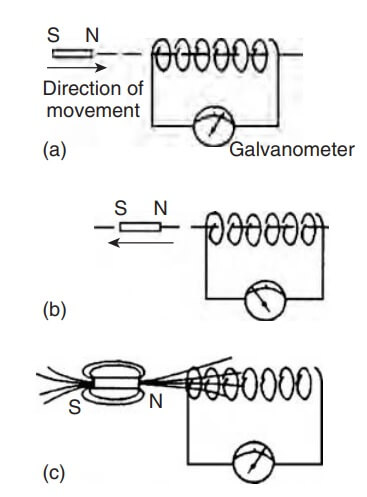When a conductor is moved across a magnetic field so as to cut through the lines of force (or flux), an electro motive force (e.m.f) is produced in the conductor. If the conductor forms part of a closed circuit then the e.m.f produced causes an electric current to flow round the circuit. Hence an e.m.f (and thus current) is ‘induced’ in the conductor as a result of its movement across the magnetic field. This effect is known as ‘electromagnetic induction’.

Figure (a) shows a coil of wire connected to a centre-zero galvanometer, which is a sensitive ammeter with the zero-current position in the centre of the scale.
- When the magnet is moved at constant speed towards the coil (Fig (a)), a deflection is noted on the galvanometer showing that a current has been produced in the coil.
- When the magnet is moved at the same speed as in (a) but away from the coil the same deflection is noted but is in the opposite direction (see Fig (b))
- When the magnet is held stationary, even within the coil, no deflection is recorded.
- When the coil is moved at the same speed as in (a) and the magnet held stationary the same galvanometer deflection is noted.
- When the relative speed is, say, doubled, the galvanometer deflection is doubled.
- hen a stronger magnet is used, a greater galvanometer deflection is noted.
- When the number of turns of wire of the coil is increased, a greater galvanometer deflection is noted.
Figure (c) shows the magnetic field associated with the magnet. As the magnet is moved towards the coil, the magnetic flux of the magnet moves across, or cuts, the coil. It is the relative movement of the magnetic flux and the coil that causes an e.m.f and thus current, to be induced in the coil. This effect is known as electromagnetic induction.
| Read More Topics |
| Force on a current carrying conductor |
| Magnetic field due to an electric current |
| Capacitors connected in parallel and series |
| Alternative and renewable energy sources |





